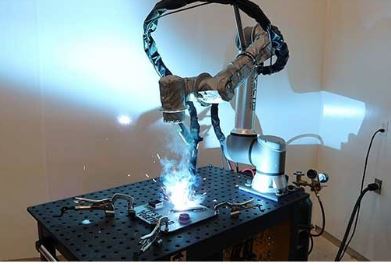The demand for skilled welders is rising as experienced professionals retire and the need for metal fabrication increases, creating an urgent need for new talent in various industries. While the labor shortage is causing stress for companies, it creates an exciting new opportunity and career path for students because companies are incorporating welding robots to help with labor shortages. Students can combine interests in robotics and programming with welding to enter a field with plenty of available jobs now and for years to come. Let's explore automated welding and why your metal fabrication program will benefit by teaching students to use welding robots.
The History of Welding Robots
There has been an increase in automation and robotics in welding recently, but it's not an entirely new concept. In 1962, George Devol and Joseph Engelberger invented the first robotic welder. The Unimation 001 was deployed in a General Motors factory for spot welding on an assembly line, a process that was hazardous for humans to perform.
In the 1980s, robotic welding became more popular, especially in the automotive manufacturing industry for robotic spot welding procedures. Today, robots are helping with many welding processes, including:
- Spot welding
- Arc welding
- Resistance welding
- TIG welding
- MIG welding
- Laser welding
- Plasma welding
Why Welding Robots Are Used in the Industry
The labor shortage in welding is increasing due to rising demand and the retirement of experienced welders. It is projected that 360,000 new welding professionals will be needed in the United States by 2027. The labor shortage has significantly increased manufacturing companies' adoption of welding robots to keep up.
In addition, welding robots contribute by helping in ways that humans are not capable of. Robotic welding helps ensure a higher level of precision than humans can perform over long periods of time and robots can produce larger volumes. They also increase safety for people by taking on hazardous tasks. Overall product quality improves with the help of automated welding and complements manual welding.
The Outlook for Welding Robot Jobs
The automotive industry has been using welding robots for half a century. Other industries have also adopted automated welding, including aerospace, shipbuilding, and construction. Welding robots need human intervention, producing a new set of careers for people to program, maintain, and operate them. Here are some examples of welding robot jobs at New England companies:
General Dynamics in Rhode Island is hiring a Robotic Welder for submarines. Responsibilities include basic robot operation, inspection and servicing, in addition to hand welding. Preferred skills for this job include structural or pipe RT hand welding, CAD/CAM training, and technical knowledge of robotic systems.
Canam in New Hampshire is hiring a Welding Robot Programmer to program, maintain, and operate robotic welding systems for bridge steel fabrication. Qualifications include experience with robotic systems and robotic welding, CAD/CAM software experience, and familiarity with programming languages for robotics and welding principles.
Brose in Massachusetts is hiring a Maintenance Technician for Robotic Welding to set up and maintain the mechanical, pneumatic, and electrical welding fixtures. Desired skills include experience with PLCs and robotic systems.
Why Metal Fabrication Programs Need Welding Robots
Companies are using welding robots now, and usage will continue to grow, so teaching students these skills will put them a step ahead when starting a career. Teaching students about welding robots also gives them well-rounded skills by learning welding principles plus robotic systems. These two areas challenge them in different ways.
The Vectis Cobot Welding Robot powered by Universal Robots is a solid solution for helping students understand both concepts. The robot is easy to learn with no coding or programming experience and comes with an online training academy for your metal fab class. The welding cobot comes on a mobile cart and is safe to move around a shop for students to be near.
Hand welding is not going away, but the industry is evolving by incorporating automation and welding robots. Students will not only be exposed to new ways of thinking from learning about welding robots, but they will also be setting themselves up for successful career paths at companies in desperate need of workers with these skills.
AET Labs is here to help you incorporate welding robots into your curriculum. We can help you identify the best welding robot for your shop and train your instructors on how to use the robot and incorporate it into their metal fabrication program. Contact us today to get started!


